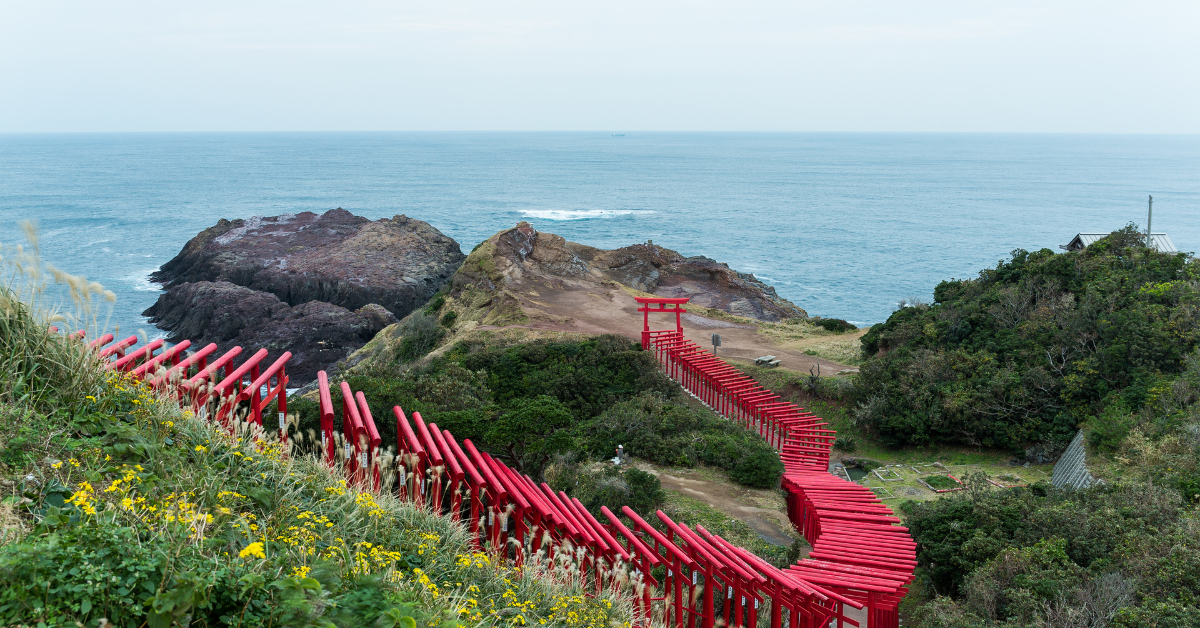Located in Nagato City, Yamaguchi Prefecture, Motonosumi Shrine is famous for its 123 red torii gates stretching toward the sea. Japanese people praise it as a “photogenic shrine”, making it a highly valued destination among both locals and travelers.
What is Motonosumi Shrine
Motonosumi Shrine was founded in 1955, making it relatively new compared to many historic shrines in Japan. It was established following a divine message from a white fox, instructing locals to build a shrine on this spot. Since then, it has been cherished as a place to pray for safe fishing voyages and prosperous business. The long path of 123 vermilion torii gates leading to the sea creates a breathtaking view and is often seen as a symbol of Japanese aesthetics.
| Feature | Description |
|---|---|
| Number of Torii gates | 123 |
| Year of founding | 1955 |
| Blessings | Prosperity in business, safety at sea |
| Main attraction | Contrast of red torii and the blue sea |
How Japanese People View It
Japanese visitors often describe Motonosumi Shrine as a place to enjoy spectacular scenery combined with playful elements. The striking contrast of red torii gates and the vivid blue sea leaves a strong impression, making it a favorite spot for photography. With the rise of social media, images of this view spread quickly, increasing its popularity.
A famous feature of the shrine is the unique offertory box placed high above a torii gate. Visitors toss coins toward it, and if they land inside, their wishes are said to come true. This fun challenge is enjoyed by both children and adults, making it a memorable experience for many.
At the same time, for local residents, Motonosumi Shrine remains more than a tourist attraction. It is still used for New Year’s visits, festivals, and daily prayers, showing that the shrine holds both spiritual and cultural importance.
| Group | Japanese Opinions |
|---|---|
| Younger visitors | “It’s fun to come with friends and take photos” |
| Families | “Children enjoy trying the offertory box, it becomes a memory” |
| Older generation | “It has long been a sacred place; we’re proud it’s known worldwide” |
What Foreign Visitors Should Understand
Foreign travelers can gain a deeper experience by understanding the Japanese perspective.
| Point | Explanation |
|---|---|
| Value as a scenic spot | The combination of gates and sea represents Japanese aesthetics |
| Sacred place for locals | Beyond tourism, it remains a prayer site for residents |
| The offertory box | Tossing coins into a high box is a rare and unique experience in Japan |
What Japanese People Find Appealing and the Challenges
While many Japanese describe Motonosumi Shrine as a “must-see view of a lifetime,” the growth of tourism has also brought challenges. On holidays, congestion and limited parking become issues. With the rise in visitors, maintaining etiquette and protecting the environment have become important topics.
| Aspect | Japanese Opinions |
|---|---|
| Appeal | “Scenery changes beautifully with each season” “Spirituality and nature coexist here” |
| Challenges | “Crowded times reduce the shrine’s quietness” “Access is limited” |
| Advice | “Visiting early morning or weekdays preserves the original atmosphere” |
Enjoying It by Season
Japanese people often revisit Motonosumi Shrine to enjoy its changing appearance across the seasons. Each season provides a new expression, making it attractive year-round.
| Season | Scenic Feature | Japanese Opinions |
|---|---|---|
| Spring | Red gates with fresh greenery and cherry blossoms | “A gentle and calming atmosphere” |
| Summer | Bright blue sky and sea contrasting with red torii | “The most vivid season, great for photos” |
| Autumn | Red leaves blending with the gates | “A sense of peace and quiet” |
| Winter | Rough waves crashing against the gates | “Feel the raw power of nature” |
Conclusion
Motonosumi Shrine is regarded by Japanese people as a place where stunning scenery and spiritual belief coexist. For tourists, it offers a photogenic landscape, while for locals, it remains a sacred site of prayer. Foreign visitors who understand both aspects will gain a deeper appreciation. Experiencing the changing seasonal views and the unique offertory box challenge allows travelers to share in the same sense of wonder that Japanese people feel.






